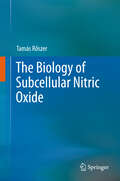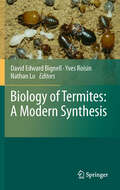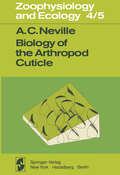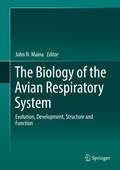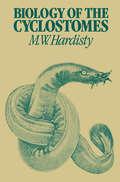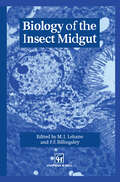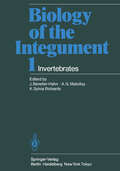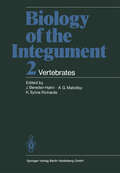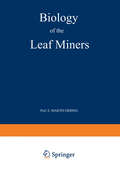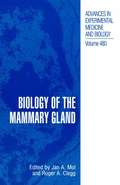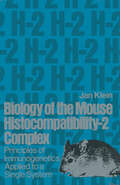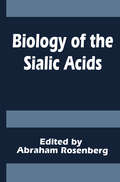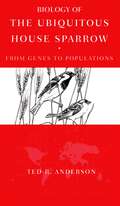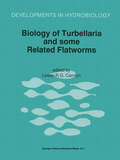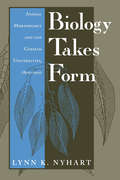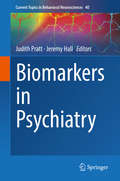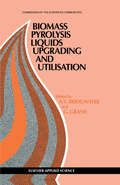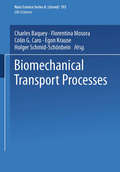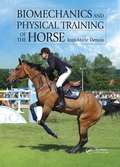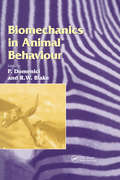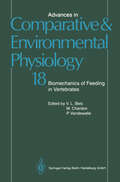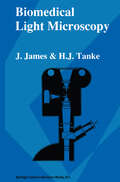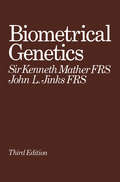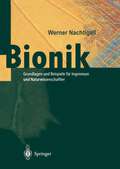- Table View
- List View
The Biology of Subcellular Nitric Oxide
by Tamás RőszerThis book fills in a gap in the NO literature. Recent progress in the field of NO-biology shows that NO is generated within distinct cell compartments, including specific plasma membrane regions, mitochondria, chloroplasts, peroxisomes, the Golgi-complex and intracellular membrane systems. NO synthesis plays specific roles in these compartments and, in turn, cell organelles also control intracellular NO levels. This monograph focuses on the roles played by the subcellular NO-signaling microdomains in the prokaryote-, fungus-, plant- and animal cells and shows how NO behaves as an intracellular signal in distinct cellular environments. This monograph also provides a summary of our knowledge on how NO synthesis came through evolution to be associated with organelles and subcellular compartments. Promotes the novel ideas that some functions of NO and its associations with subcellular units have been conserved during the evolution of the cell. A special chapter is dedicated to the biomedical relevance of subcellular NO synthesis, and this chapter also discusses the evidence that altered compartmentalization of NO-producing enzymes causes disease.
Biology of Termites: a Modern Synthesis
by David Edward Edward Bignell, Yves Roisin and Nathan LoBiology of Termites, a Modern Synthesis brings together the major advances in termite biology, phylogenetics, social evolution and biogeography. In this new volume, David Bignell, Yves Roisin and Nathan Lo have brought together leading experts on termite taxonomy, behaviour, genetics, caste differentiation, physiology, microbiology, mound architecture, biogeography and control. Very strong evolutionary and developmental themes run through the individual chapters, fed by new data streams from molecular sequencing, and for the first time it is possible to compare the social organisation of termites with that of the social Hymenoptera, focusing on caste determination, population genetics, cooperative behaviour, nest hygiene and symbioses with microorganisms. New chapters have been added on termite pheromones, termites as pests of agriculture and on destructive invasive species.
Biology of the Arthropod Cuticle (Zoophysiology #4/5)
by A.C. NevilleMention the words 'arthropod cuticle' to most biologists and they usually provoke a glazed expression. This is because the cuticle is commonly regarded as an inert substance. It is hoped that this book will dispel this fallacy. The study of cuticle in its proper context now involves many of the wider aspects of biology which are currently in vogue (e. g. how a hormone like ecdyson induces a specific enzyme like dopa decarboxylase; the unsolved major problem of cell gradient and polarity; the involvement of cyclic AMP in hormonal mechanisms; the extra cellular control of cuticular enzymes, of the mechanical proper ties of cuticle structural proteins, and of the orientation of fibrous molecules; and the relation of chromosome puffing to the synthesis of specific proteins). Studies on cuticle demand a variety of techniques, and examples of the following are illustrated in this book (fluorescence, phase contrast, polariza tion and Nomarski interference microscopy; infrared absorp tion; transmission and scanning electron microscopy; autora diography analyzed by electron microscopy; negative staining in the electron microscope; optical diffraction, high angle X-ray diffraction, low angle X -ray diffraction and selected area electron diffraction). I am well aware that the biophysical parts of this book are less incomplete than other aspects. A developmental biologist or a biochemist would have further elaborated other parts ofthe subject matter. Only one previous author, RICHARDS (1951)hasdevoted a book to arthropod cuticle.
The Biology of the Avian Respiratory System: Evolution, Development, Structure and Function
by John N. MainaThe central focus of this book is the avian respiratory system. The authors explain why the respiratory system of modern birds is built the way it is and works the way that it does. Birds have been and continue to attract particular interest to biologists. The more birds are studied, the more it is appreciated that the existence of human-kind on earth very much depends directly and indirectly on the existence of birds. Regarding the avian respiratory system, published works are scattered in biological journals of fields like physiology, behavior, anatomy/morphology and ecology while others appear in as far afield as paleontology and geology. The contributors to this book are world-renowned experts in their various fields of study. Special attention is given to the evolution, the structure, the function and the development of the lung-air sac system. Readers will not only discover the origin of birds but will also learn how the respiratory system of theropod dinosaurs worked and may have transformed into the avian one. In addition, the work explores such aspects as swallowing mechanism in birds, the adaptations that have evolved for flight at extreme altitude and gas exchange in eggs. It is a highly informative and carefully presented work that provides cutting edge scientific insights for readers with an interest in the respiratory biology and the evolution of birds.
Biology of the Insect Midgut
by M. Lehane P. BillingsleyEntomological research benefits from a great diversity of technical approaches - from the molecular to the descriptive - and these are applied to an even greater diversity of insect species. As a consequence, common themes and trends in entomological research can often be overlooked as each researcher focuses on his or her own area of interest. The purpose of this volume is to bring together diverse areas of research under one common theme. The book is divisible into four conceptual areas: the structural biology of the midgut; digestion and transport; the insect midgut as a target for control strategies; and the idgut as an environment for other organisms. Each chapter is written by scientists active in the reviewed research area and a truly international team of contributors has been chosen by the editors. Biology of the Insect Midgut will be of immense use to advanced undergraduate and postgraduate students, and researchers in entomology, physiology and pest control.
Biology of the Integument: Invertebrates
by J. Bereiter-Hahn A. G. Matoltsy K. S. RichardsThe integument plays an important role in the survival of meta zoans by separating and protecting them from a hostile environ ment. Its function ranges from protection against injury and in fection; partlcipation in the regulation of body temperature and water balance, to respiratory activity, monitoring of the environ ment and production of signals related to behaviour. All these result from specific structural, biochemical and physiological properties of intra-and extracellular components of the integu ment. Thus its characterization can be best accomplished by a multidisciplinary approach with authors specialized in different fields of science. This multi-author book, in two volumes, provides an up-to date survey of the literature. The first volume deals with the integument of invertebrates, the second with that of vertebrates, both organized primarily on a phylum basis. As the level of knowledge on the integument of phyla differs considerably, the information provided is correspondingly either limited or con densed. For some of the smaller groups of invertebrates little information is available, as often only a few electron micrographs are to be found in the literature; on the other hand, from the large body of knowledge existing for vertebrates, particularly for mammals, no complete overview can be provided, but publica tions giving access to further information have been reviewed critically.
Biology of the Integument: 2 Vertebrates
by J. Bereiter-Hahn A. G. Matoltsy K. S. RichardsThe integument plays an important role in the survival of meta zoans by separating and protecting them from a hostile environ ment. Its function ranges from protection against injury and in fection, participation in the regulation of body temperature and water balance, to respiratory activity, monitoring of the environ ment and production of signals related to behaviour. All these result from specific structural, biochemical and physiological properties of intra-and extracellular components of the integu ment. Thus its characterization can be best accomplished by a multidisciplinary approach with authors specialized in different fields of science. This multi-author book, in two volumes, provides an up-to date survey of the literature. The first volume deals with the integument of invertebrates, the second with that of vertebrates, both organized primarily on a phylum basis. As the level of knowledge on the integument of phyla differs considerably, the information provided is correspondingly either limited or con densed. For some of the smaller groups of invertebrates little information is available, as often only a few electron micrographs are to be found in the literature ; on the other hand, from the large body of knowledge existing for vertebrates, particularly for mammals, no complete overview can be provided, but publica tions giving access to further information have been reviewed critically.
Biology of the Leaf Miners
by E.M. HeringThe development of specialised feeding habits during the course of time by human beings is paralleled in the majority of animals, in particular have developed special peculiarities, and insect larvae which in most cases are quite characteristic of the species concerned. This applies especially to phytophagous insect larvae, and anyone with the requisite experience can say with a fair degree of certainty which insect larva is responsible for any damage to be found on a plant. It leaves behind a definite "feeding pattern" which might be compared to a "visiting card" on which the genus and species are marked in runic characters. Whoever has learned to read the runes can readily determine who has been feeding on the affected spot, solely on the basic of the "visiting card" left behind. From the known factors - the name of the plant and the type of feeding patter- and after some study of the various types of plant infestation, both the genus and species of the larva producing the feeding pattern can be worked out without difficulty. The importance of "feeding pattern investigation" has now far outstripped the successes to be obtained by normal collecting. Previously, when wishing to list the species of insects present in any given locality they were caught with the net, by sugaring and other methods. This always resulted in a very defective "list" of the insects in fact existing in the locality concerned.
Biology of the Mammary Gland (Advances in Experimental Medicine and Biology #480)
by Roger A. Clegg John A. MolProceedings of the European Cooperation in the Field of Scientific and Technical Research (COST 825) Symposium on Mammary Gland Biology, held September 16-18, 1999, in Tours, France. It is difficult to overstate the evolutionary and functional significance of mammary tissue in biology. Substantial progress has been made by researchers in various disciplines, particularly over the last fifteen years, towards realizing the potential of this tissue to yield powerful experimental models for morphogenesis and tissue development; for cellular differentiation; for the biosynthesis and secretion of proteins, lipids, small molecules and inorganic salts; and for the coordination and regulation of these processes. More recently, the possibility of exploiting the secretory epithelial cells of mammary tissue as `cell factories' has become a reality and the recombinant production by lactating animals of an increasing number of proteins, valuable both in the pharmaceutical and `nutraceutical' fields, is in progress or under development. Also in this sphere of agricultural production, genetic as well as nutritional technologies are under investigation and exploitation to optimize milk composition for various end-uses - for instance in food process and manufacture. The possibilities of deriving health benefit from the bioactive properties of some of the minor constituents of milk are emerging to counter the highly-publicized negative health impact of excessive consumption of saturated animal fats. In human nutrition and medicine, the mammary gland is both a source of nutrition to the neonate and a potential health threat to the adult female - breast cancer remains the major single cause of female mortality in most developed countries. This volume provides a unique glimpse into our understanding, at the cutting edge of a variety of disciplines, of this versatile and extraordinary tissue, at the birth of the twenty-first century.
Biology of the Mouse Histocompatibility-2 Complex: Principles of Immunogenetics Applied to a Single System
by J. de KleinSomewhere I heard a story of a bridge and a painter. The bridge was enormous and was made all of metal, and the painter's job was to keep it from rusting. He would start at one end and slowly proceed, day by day, month by month, toward the other end, painting the bridge. But no sooner would he finish with the painting than the bridge would begin to rust again. The rust, too, would start at one end and slowly proceed toward the other end, systematically destroying the painter's endeavor. And so the painter would return to where he had started, and begin painting again, slowly proceeding toward the other end of the bridge, always just one step ahead of the rust. And if the story is true, the painter might still be painting that bridge-a modern Sisyphus! During the writing of this book, the story of the painter and his bridge kept coming to mind. The field the book covers has been developing so rapidly that, like the painter, I too had to return to where I had started and fight the rust of obsolescence. But unlike the painter, I had a deadline to meet, which constituted a point of no return. And so, sending off this manuscript, I have no choice but to watch the fruits of my endeavor be overtaken by the rust.
Biology of the Sialic Acids
by A. RosenbergAbraham Rosenberg assembles the groundbreaking work of preeminent international scientists to provide the most current, state-of-the-art presentation of research in siabiology. This concise volume examines the historical development of the field and reviews current knowledge on the genetic, immunologic, oncologic, neurodevelopmental, pathogenic, and cell regulatory properties of sialic acid. Outstanding features of this work include exhaustive reference material and detailed information tables.
Biology of the Ubiquitous House Sparrow: From Genes to Populations
by Ted R. AndersonAfter the chicken, the House Sparrow is the most widely distributed bird species in the world, occurring on all continents except Antarctica and on most human-inhabited islands. Although its Latin name is Passer domesticus, it is certainly not domesticated. In fact, it is widely regarded as a pest species and is consequently not protected in most of its extensive range. This combination of ubiquity and minimal legal protection has contributed to its wide use in studies by avian biologists throughout the world. The purpose of this book is to review and summarize the results of these global studies on House Sparrows, and to provide a springboard for future studies on the species. House Sparrows have been used to study natural selection in introduced species, circadian rhythms, and the neuroendocrine control of the avian annual cycle. One current question of considerable interest concerns the catastrophic House Sparrow population declines in several urban centers in Europe. Is the House Sparrow a contemporary canary in the mine? Other topics of broad interest include the reproductive and flock-foraging strategies of sparrows, and sexual selection and the function of the male badge in the species. Anderson also explores the role of the House Sparrow in disease transmission to humans and their domesticated animals.
Biology of Turbellaria and some Related Flatworms: Proceedings of the Seventh International Symposium on the Biology of the Turbellaria, held at Åbo/Turku, Finland, 17–22 June 1993 (Developments in Hydrobiology #108)
by Lester R. G. CannonTurbellaria, the mainly free-living flatworms, and some of their parasitic relatives, are among the simplest of the metazoa and, as such, provide ideal models for a wide range of fundamental studies. The 60 contributions to Biology of Turbellaria and some Related Flatworms cover taxonomy and phylogeny, biogeography and genetics, ecology and behaviour, Anatomy and ultrastructure, development and regeneration, genes and sequences, and neurophysiology. Biology of Turbellaria and some Related Flatworms is the most recent compilation in the series published in Hydrobiologia since 1981, covering research on these flatworms assembled by the world's leading authorities on the group. Audience: These papers present the advanced student and serious researcher with up to date information on an important, but often neglected group whose place in the animal kingdom demands greater attention.
Biology Takes Form: Animal Morphology and the German Universities, 1800-1900 (Science and Its Conceptual Foundations series)
by Lynn K. NyhartMorphology—the study of form—is often regarded as a failed science that made only limited contributions to our understanding of the living world. Challenging this view, Lynn Nyhart argues that morphology was integral to the life sciences of the nineteenth century. Biology Takes Form traces the development of morphological research in German universities and illuminates significant institutional and intellectual changes in nineteenth-century German biology. Although there were neither professors of morphology nor a morphologists' society, morphologists achieved influence by "colonizing" niches in a variety of disciplines. Scientists in anatomy, zoology, natural history, and physiology considered their work morphological, and the term encompassed research that today might be classified as embryology, systematics, functional morphology, comparative physiology, ecology, behavior, evolutionary theory, or histology. Nyhart draws on research notes, correspondence, and other archival material to examine how these scientists responded to new ideas and to the work of colleagues. She examines the intertwined histories of morphology and the broader biological enterprise, demonstrating that the study of form was central to investigations of such issues as the relationships between an animal's structure and function, between an organism and its environment, and between living species and their ancestors.
Biomarkers in Psychiatry (Current Topics in Behavioral Neurosciences #40)
by Judith Pratt Jeremy HallThis volume addresses one of the Holy Grails in Psychiatry, namely the evidence for and potential to adopt ‘Biomarkers’ for prevention, diagnosis, and treatment responses in mental health conditions. It meshes together state of the art research from international renowned pre-clinical and clinical scientists to illustrate how the fields of anxiety disorders, depression, psychotic disorders, and autism spectrum disorder have advanced in recent years.
Biomass Pyrolysis Liquids Upgrading and Utilization
by A. V. Bridgwater G. GrassiBiomass pyrolysis has been practised for centuries in the manufacture of charcoal for industry and leisure. Only in the last two decades, however, has attention focussed on a better understanding of the science and technology, with the resultant benefits of better designed and controlled processes that give high yields of liquid products. These liquids, or 'bio-oil' as it is referred to, can be used in a variety of ways: -combustion to replace conventional fuel oil in boilers, process equipment such as kilns and in gas turbines for power generation; -upgrading by hydrotreating or with zeolites to gasoline, diesel and other hydrocarbon fuels, of chemicals; --extraction and upgrading to fuel additives and chemical specialities. Any charcoal produced can also be utilised to form char- water slurries, analogous to coal-water slurries, or bioi-oil slurries which may be used as liquid fuels in many combustion applications. A group of experts was set up in the EC Energy from Biomass programme to evaluate the status and opportunities for deriving useful liquid products from biomass pyrolysis. This book is a report of their findings and conclusions. It forms an authoritative guide to the wide range of technologies employed in biomass pyrolysis, and product upgrading, utilisation and characterisation. Recommendations and conclusions are included to identify promising areas of research and development that will be of value to researchers, planners and companies throughout the world.
Biomechanical Transport Processes (Nato Science Series A: #193)
by Charles BaqueyProceedings of a NATO ARW held in Cargese, France, October 9-13, 1989
Biomechanics and Physical Training of the Horse
by Jean-Marie DenoixEffective horse trainers strive to improve the performance of their horses while preserving the integrity of the musculoskeletal apparatus. Biomechanics and Physical Training of the Horse supplies an anatomical and functional overview of the topic, enabling trainers to optimize the different exercises their horses undergo during training and compet
Biomechanics in Animal Behaviour
by R. W. Blake P. DomeniciBiomechanics in Animal Behaviour offers a unique approach by integrating fully the fields of animal behaviour and biomechanics. It demonstrates how an understanding of biomechanical issues is an important part of evaluating and predicting animal behaviour. The book examines how behaviour is determined and/or constrained by biomechanical variables such as hydrodynamics, aerodynamics, kinematics, and the mechanical properties of biomaterials.
Biomechanics in Animal Behaviour
by P. DOMENICI; R.W. BLAKEBiomechanics in Animal Behaviour offers a unique approach by integrating fully the fields of animal behaviour and biomechanics. It demonstrates how an understanding of biomechanical issues is an important part of evaluating and predicting animal behaviour. The book examines how behaviour is determined and/or constrained by biomechanical variables such as hydrodynamics, aerodynamics, kinematics, and the mechanical properties of biomaterials.
Biomechanics of Feeding in Vertebrates (Advances in Comparative and Environmental Physiology #18)
by V. L. Bels P. Aerts M. Chardon P. Vandewalle H. Berkhoudt A. W. Crompton F. De Vree P. Dullemeijer J. P. Ewert T. H. Frazzetta C. Gans S. W. Herring A. Huysseune K. V. Kardong G. V. Lauder S. M. Reilly E. Schürg-Pfeiffer W. W. Schwippert D. N. Stern J.C. Vanden Berge W. Verraes A. Weerasuriya W. A. Weijs C. B. Wood G. A. ZweersAlthough feeding is not yet been thoroughly studied in many vertebrates taxa, and different conceptual and methodological approaches of the concerned scientists make a synthesis difficult, the aim of the editors is to provide a comprehensive overview of the feeding design in aquatic and terrestrial vertebrates with a detailed description of its functional properties. The book emphasizes the constant interaction between function and form, behaviour and morphology in the course of evolution of the feeding apparatus and way of feeding both complementary and basically related to survival interspecific competition, adaptation to environmental changes and adaptive radiations. Special stress is drawn onquantification of the observational and experimental data on the morphology and biomechanics of the feeding design and its element jaws, teeth, hyoidean apparatus, tongue, in order to allow present and further comparisons in an evolutionary perspective.
Biomedical Light Microscopy
by J. James H.J TankeNew interest in light microscopy of the last few years has not been backed up by adequate general literature. This book intends to fill the gap between specialized texts on detailed topics and general introductory booklets, mostly dealing with the use of the conventional light microscope only. In this short textbook both new developments in microscopy and basic facts of image formation will be treated, including often neglected topics such as axial resolving power, lens construction, photomicrography and correct use of phase-en interference contrast systems. Theoretical background will be dealt with as far as necessary for a well-considered application of these techniques enabling a deliberate choice for the approach of a certain problem. Over 150 illustrations (photomicrographs and diagrams) complete the information on microscopy of the nineties in the biomedical field, intended for scientists, doctors, technicians and research students. Many drawings have been contributed by the illustrator R. Kreuger; the photographic work has been executed by J. Peeterse. Secretarial assistance in preparing the manuscript was given by Ms T. M. S. Pierik. Dr M. J. Pearson has corrected the English of the final text.
Biometrical Genetics: The Study of Continuous Variation
by Kenneth Mather John L. JinksThe properties of continuous variation are basic to the theory of evolution and to the practice of plant and animal improvement. Yet the genetical study of continuous variation has lagged far behind that of discontinuous variation. The reason for this situation is basically methodological. Mendel gave us not merely his principles of heredity, but also a method of experiment by which these principles could be tested over a wider range ofliving species, and extended into the elaborate genetical theory of today. The power of this tool is well attested by the speed with which genetics has grown. In less than fifty years, it has not only developed a theoretical structure which is unique in the biological sciences, but has established a union with nuclear cytology so close that the two have become virtually a single science offering us a new approach to problems so diverse as those of evolution, development, disease, cellular chemistry and human welfare. Much of this progress would have been impossible and all would have been slower without the Mendelian method of recognizing and using unit differences in the genetic materials. These great achievements should not, however, blind us to the limitations inherent in the method itself. It depends for its success on the ability to assign the individuals to classes whose clear phenotypic distinctions reveal the underlying genetic differences.
Bionik: Grundlagen und Beispiele für Ingenieure und Naturwissenschaftler
by Werner NachtigallDieses umfassende Lehrbuch wendet sich an Studenten, Fachleute und Wissenschaftler und liegt somit im Niveau deutlich über den üblichen Sachbüchern zur Bionik. In einem umfangreichen allgemeinen Teil zeigt der Autor, was Bionik ist, wie sie sich entwickelt hat, wie man Fragen stellt und was Bionik leisten kann. Darauf folgen detaillierte Darstellungen von 40 ausgewählten Beispielen aus den verschiedensten technolgischen Bereichen. Die vielfältigen Facetten dieser interdisziplinären Wissenschaft fügen sich in diesem anspruchsvollen Werk puzzleartig zu einer "Biostrategie in die Zukunft" zusammen.
